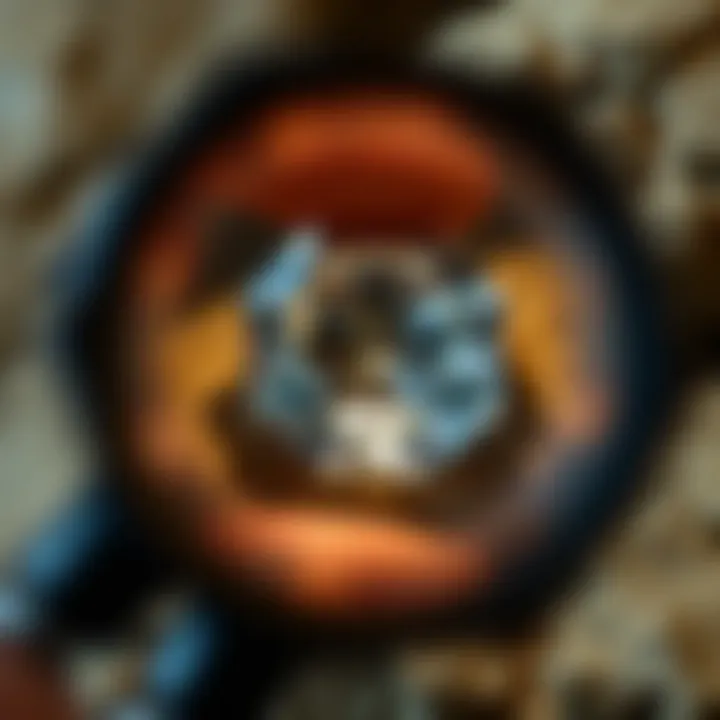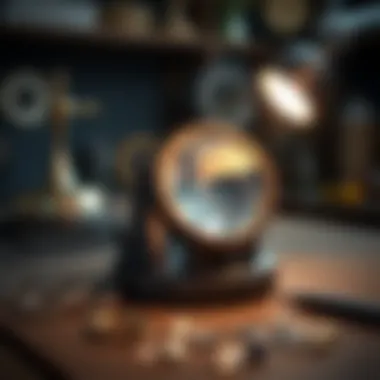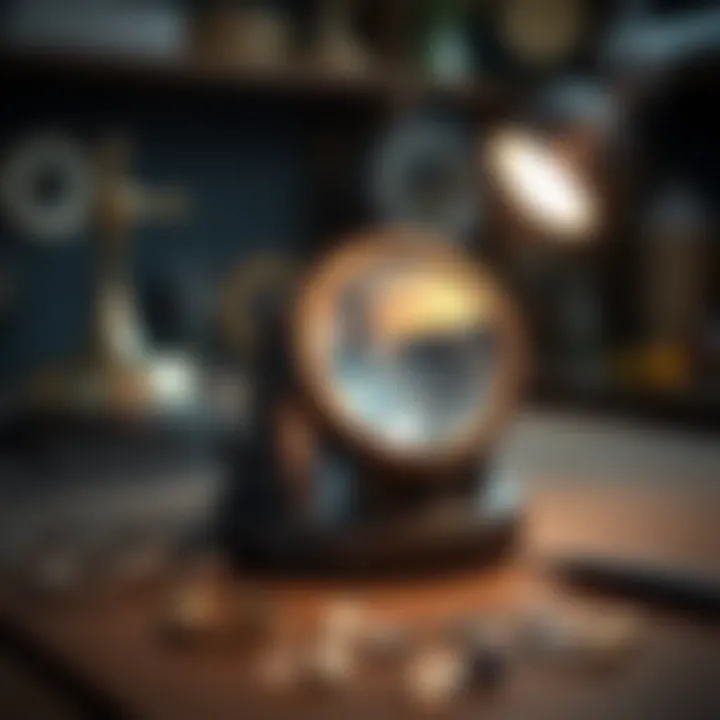The Essential Guide to Lighted Jewelers Magnifiers


Intro
In the delicate interplay of light and vision, lighted jewelers magnifiers stand out as essential tools for precision work. These devices are not just accessories; they are a gateway to enhancing the art of jewelry making and the science of fossil collection. The ability to observe intricate details expands the artist's creativity and the collector's understanding. With these magnifiers, one can reveal the fine nuances of gemstones and the delicate structures of fossils, allowing for a deeper appreciation and meticulous craftsmanship.
Choosing the right magnifier can feel daunting with so many options available. It's not merely about what looks good under the counter—it's about which tool enhances your specific needs, whether you're inspecting a family heirloom or discovering a rare fossil piece. Understanding the unique features and functionalities of each magnifier type can significantly elevate your experience. This guide aims to unravel these complexities and present you with the necessary information to make informed decisions, care for your tools, and ultimately hone your skills in your respective craft.
So, let’s embark on this journey to understand the world of lighted jewelers magnifiers, shedding light on their evolution, their critical role in art and science, and how to make the most of them in your pursuit of beauty and knowledge.
Understanding Lighted Jewelers Magnifiers
In the realm of jewelry making and fossil collection, precision is crucial. This is where lighted jewelers magnifiers come into play. They’re not just tools; they’re indispensable aids that enhance the ability to scrutinize fine details, ensuring high-quality craftsmanship and accurate evaluations. Understanding their significance is vital for anyone keen on producing or evaluating intricate work.
Definition and Purpose
A lighted jeweler’s magnifier is a specialized optical device designed for viewing small objects in detail, coming equipped with an integrated light source. Its primary purpose is to illuminate the subject being examined, which can range from gemstones to intricate fossil patterns. For instance, when examining a diamond’s clarity, even the tiniest blemish can impact its value. The magnifier allows jewelers to see these minute details more clearly, promoting accurate appraisals and ensuring integrity in craftsmanship.
Key Features of Lighted Magnifiers
When selecting a lighted magnifier, there are various key features to consider:
- Illumination Type: Many magnifiers utilize LED lighting due to its bright, energy-efficient properties, enhancing visibility without generating excessive heat.
- Magnification Power: Most models offer different levels of magnification, which can vary from 5x to 30x. The right choice depends on the specific tasks you need to perform.
- Lens Quality: The clarity and distortion level of the lens play a vital role, as cheaper lenses may obscure details instead of revealing them. High-quality glass lenses provide better clarity.
- Adjustability: Features such as focus adjustment or height modifications can greatly improve comfort during extended usage.
Having a decent grasp of these features enables users to select a magnifier suited to their unique needs, ensuring that their investigative experiences are both enjoyable and productive.
"In jewelry making and fossil collection, details matter. A lighted jewelers magnifier shines the light needed to find those details."
Pursuing knowledge about lighted jewelers magnifiers empowers collectors and creators alike, ultimately refining their craft and appreciation for the finer things in life.
Types of Lighted Jewelers Magnifiers
When it comes to precision work, the type of magnifier significantly influences both the effectiveness and ease of the task at hand. Lighted jewelers magnifiers come in various styles, each offering unique benefits tailored to different needs. Understanding these types can aid enthusiasts, from jewelers to rock collectors, in making informed choices that elevate their work. Whether you’re focusing on intricate designs or scanning through a collection of fossils, selecting the right magnifier matters greatly.
Handheld Magnifiers
Handheld magnifiers are among the most popular options, favored for their flexibility and ease of use. Typically lightweight and portable, these magnifiers allow for quick examination of objects without the need for a fixed setup. They are particularly advantageous during fieldwork, where flexibility is crucial. A collector can easily carry a handheld magnifier in a pocket, making it an ideal companion when out exploring potential sites for fossil hunting or gem collecting.
One standout feature of handheld magnifiers is their typically strong magnification power, often ranging from 2.5x to 10x. This enables users to see fine details that might otherwise remain hidden. The built-in LED light often found in these models is a game changer, as it illuminates the subjects being studied, enhancing visibility in low-light conditions.
With handheld models, comfort is essential. Users should pay attention to the handle’s design; a comfortable grip can prevent fatigue during extended use, especially when examining larger specimens or intricate details. It’s also worth noting that some models offer adjustable light intensity, allowing for customization based on specific examination conditions.
Tabletop Magnifiers
Tabletop magnifiers, also known as desk or stand magnifiers, bring an entirely different set of advantages to the table. These devices are stationary, securely positioned on any flat surface, which allows for hands-free operation. This can be particularly beneficial for tasks requiring substantial focus, such as detailed repair work on jewelry or fossil examination.
The magnification power on tabletop devices often exceeds that of handhelds, commonly going up to 20x or even 30x in some advanced models. This magnification is accompanied by a larger lens, providing a more comprehensive view of the object at hand. Collectors may find that a tabletop magnifier offers an easier way to inspect intricate details of a rock or piece of jewelry while keeping both hands free to work or jot down notes.
Another noteworthy element is the lighting. Many tabletop magnifiers come with excellent built-in lighting systems, incorporating halogen or LED lights. These lighting options often provide a broad and even illumination, reducing shadows that can obscure important details—a feature cherished by anyone who's spent time scrutinizing wear on a rare coin or the delicate patterns of mineral formations in fossils.
Headband Magnifiers
Headband magnifiers, often resembling the look of a miner's headlamp, are designed for hands-free convenience. They rest comfortably over your head and can be adjusted to sit directly over the eyes. This can be particularly appealing for jewelers or collectors who need ample freedom while working, whether it involves soldering, crafting, or inspecting tiny details in fossil specimens.
The magnification range for these types hovers around 1.5x to 3x, but they usually come with interchangeable lenses, allowing users to switch magnification levels quickly. This versatility is a major draw. Additionally, because they free the hands, headband magnifiers can significantly diminish fatigue that comes from holding devices for extended periods.
Headband models also frequently incorporate built-in lighting, usually LEDs, which may be adjustable for brightness. This gives users a clear view of what they are examining, and the ability to move naturally during work enhances efficiency. The lightweight design is another plus, as it often reduces the strain on the neck and head, making them comfortable for prolonged use.
In summary, understanding the different types of lighted jewelers magnifiers can guide enthusiasts in choosing the best tool for their specific endeavors. Whether you favor the portability of handheld models, the stability of tabletop designs, or the freedom offered by headband options, each type provides essential features that can optimize your experience in both jewelry making and fossil collecting. Choose wisely, and let the details unfold.
Importance of Illumination in Magnifiers
When it comes to jewelers and fossil collectors, the ability to see intricate details can make or break the experience. The role of illumination in magnifiers is crucial, as it enhances clarity and reveals aspects of materials that might otherwise remain unnoticed. A well-lit lens not only improves visibility but also aids in reducing eye strain, making long hours of detailed work more manageable. In the world of fine craftsmanship, illumination transcends mere convenience; it's a necessity for accuracy and efficiency.
Benefits of Built-in Lighting
Built-in lighting in magnifiers offers a myriad of advantages that cater directly to the needs of jewelers and fossil enthusiasts. First and foremost, these features often employ LED lights which provide a bright and even illumination that helps minimize shadows. This means that users can examine tiny gemstones or fossilized specimens with unrivaled precision. Additionally, built-in lighting allows for adjustable brightness levels; thus, one can tailor the light to suit particular tasks—whether it's inspecting a diamond's cut or analyzing the fossil's detail.
Key Benefits Include:
- Greater Detail Recognition: Bright lighting highlights imperfections and intricate patterns that can be easily overlooked.
- Reduced Strain on Eyes: By providing well-distributed light, users can avoid squinting and other eye strain that comes from working in dim environments.
- Convenience: No need to juggle a flashlight or worry about external light sources. Everything is integrated and ready to go.
In essence, built-in lighting transforms a simple magnifier into a powerful tool for analysis and creation. It empowers users to engage with their materials on a more profound level.
LED vs. Halogen Lighting
When discussing the type of lighting used in magnifiers, two primary options come to mind: LED and halogen. Each has its unique characteristics, and understanding these differences can significantly influence your choice of magnifier.


- LED Lighting: Generally seen as the more modern option, LED lights are celebrated for their longevity and energy efficiency. They emit less heat, which is a bonus during long sessions of work. Moreover, they provide a crisp clarity that can genuinely change the way details are perceived, making them a staple in today’s jewelry making and fossiling toolkit.
- Halogen Lighting: This type is still favored by some for its warm glow which can give colors in stones and fossils a vibrant look. However, halogen bulbs tend to consume more power and can generate additional heat. Over extended periods, this might lead to discomfort as hot bulbs can make handling delicate materials trickier.
Choosing between the two ultimately comes down to personal preference and the specific tasks at hand. While LED lighting proves to be versatile and efficient, some may find the natural color representation of halogen lighting hard to resist.
"The tools we choose to see the world around us shape our understanding of fine details, be it in gemstone or ancient bones. Choosing the right lighting is as essential as the magnifier itself."
Choosing the Right Magnifier
Selecting the appropriate lighted jewelers magnifier is not just a matter of convenience; it can make the difference between a good job and a great one. A suitable magnifier ensures clarity while you work on intricate designs or identify delicate features in your collection. When opting for a magnifier, several factors come into play that can enhance not only your work but also your overall experience.
Magnification Power
Magnification power is the first and foremost aspect to consider. It indicates how much larger an object appears through the lens. Generally, the higher the magnification, the more detail can be perceived. However, this isn’t a one-size-fits-all scenario.
For instance, a magnifier with 10x power might be ideal for observing small gemstones, while a 2x or 5x might serve better for broader inspection tasks. If you focus on minute details, consider magnifiers that reach higher powers, like those in the 12x to 20x range. But keep in mind that higher magnification can lead to a narrower field of view, which might compromise the overall perspective of a piece.
• Tip: Always check out the working distance—this is how far you can be from the object and still gain clarity.
Lens Quality
The quality of the lens is another critical factor. Poor lens quality can distort images, leading to eye strain and misinterpretation of details. A good lens should provide a clear, sharp image without color fringing or blurring. Optical glass is often preferred due to its ability to produce clearer results than cheaper plastic counterparts.
When evaluating lens quality, consider:
- Coatings: Anti-reflective coatings can reduce glare.
- Material: Higher-quality materials often result in better durability and clarity.
- Shape: Aspheric lenses are particularly beneficial as they reduce distortions across wider fields.
Investing in a quality lens is akin to investing in the longevity of your work.
Comfort and Usability
Lastly, comfort and usability are paramount when it comes to choosing a magnifier. If a magnifier isn’t easy to handle, it becomes more of a hindrance than a help. Look for features that improve comfort:
- Ergonomic designs: Handheld magnifiers should feel good in your hand, not cumbersome.
- Adjustability: Magnifiers with adjustable brightness can help tailor the lighting to your specific work environment.
- Weight: Especially for handheld or headband styles, lighter models are preferable to avoid fatigue.
In a nutshell, the right selection of a lighted jewelers magnifier hinges on a thoughtful consideration of magnification power, lens quality, and usability. Choosing wisely can turn tedious work into enjoyable exploration, whether you’re crafting beautiful jewelry or uncovering the delicate details of ancient fossils.
Applications in Jewelry Making
In the realm of jewelry making, precision is paramount. Lighted jewelers magnifiers have carved a niche for themselves, proving indispensable tools for both novice and seasoned artisans. These devices enhance a crafter's ability to see details that are otherwise missed by the naked eye, making every piece of jewelry not just a creation but a masterpiece.
Detailing and Repair
When it comes to detailing, the smallest elements can make the biggest difference. A lighted magnifier allows jewelers to scrutinize intricate designs, evaluate gemstone settings, and ensure that every facet of a piece reflects light as intended. For instance, when setting a diamond, it’s crucial to appreciate how the stone interacts with light; a magnifier assists in checking for proper alignment and setting tightness. This level of scrutiny can save costly mistakes and reduce the risk of future repairs.
An effective magnifier not only sees flaws; it brings attention to beauty often overlooked.
In the repair aspect, it's equally vital. Whether it's replacing a stone, redesigning, or repairing broken clasps, these magnifiers ensure that every step is executed with accuracy. Jewelers can identify cracks in settings or worn-down links in chains that need fixing. These magnifiers can also illuminate dark corners, where shadows might hide imperfections, fortifying the integrity of the craft and prolonging the jewelry's lifespan.
Quality Control
Quality control is another significant domain where lighted jewelers magnifiers prove their worth. Once a piece is completed, it requires thorough inspection to meet the high standards expected by consumers. Using a magnifying glass with built-in lighting not only aids in examining the piece aesthetically but also in analyzing its functionality. This assures that all components are working as they should and meet industry standards.
In this process, jewelers inspect:
- Clarity of stones: Fine imperfections may be invisible without a magnifier, leaving customers disappointed.
- Setting stability: Every stone must be securely placed, avoiding mishaps for the wearer.
- Finishing touches: Smooth edges and polished surfaces are essential, as these details contribute to the overall appeal of jewelry.
Therefore, using a lighted magnifier for quality control ensures that each piece leaving the workshop is thoroughly vetted, enhancing customer satisfaction and building trust in craftsmanship.
Role in Fossil Collection
Lighted jewelers magnifiers play a pivotal role in fossil collection, enabling both amateurs and seasoned enthusiasts to delve deep into the world of paleontology. Fossils, by their very nature, tell stories of the distant past, and understanding them often hinges on the ability to observe intricate details and textures. These magnifiers enhance the process by providing adequate lighting and powerful magnification, making it easier to study specimens.
One of the remarkable aspects of fossil collection is the diversity of materials and structures that can be encountered. From delicate leaf imprints to hard-shelled marine creatures, each fossil requires a keen eye to appreciate its unique characteristics. This is where a lighted magnifier comes into play, allowing collectors to set their sights on finer details that could easily remain obscured under normal lighting conditions.
Identifying Specimens
When identifying different types of fossils, the subtleties matter greatly. Lighted jewelers magnifiers facilitate this identification by bringing out features that distinguish one specimen from another. For example, the texture of the surface, the presence of tiny markings, or the structure of shells can often be the key to determining the species and age of a fossil.
Utilizing a lighted magnifier helps in:
- Examining Surface Patterns: Many fossils have intricate patterns. A good magnifier enables collectors to see these patterns clearly, assisting in proper classification.
- Noticing Color Variations: Often fossils can sport a range of colors that might hint at their formation environment or mineral content. Good lighting makes these variations stand out.
- Evaluating Size and Shape: The lens allows for precise measurements that are crucial in fossil identification.
- Spotting Inclusions & Defects: Sometimes, imperfections in fossils can lead to significant insights about their history.
Enhancing Detail Recognition
Detail recognition is at the heart of appreciating fossils. Lighted magnifiers excel in this area by illuminating the nuances that might be missed otherwise. When collectors look closely at a fossil, they are not just observing a relic; they are unraveling a tapestry of historical events.


Several advantages of using a lighted magnifier to enhance detail recognition include:
- Improved Visibility: Illumination provided by built-in LEDs or halogen lights highlights even the tiniest fossils found in sediment.
- Enhanced Contrast: A well-designed magnifier creates contrast between the fossil surface and its matrix, making every detail pop out.
- Facilitation of Study: With better details, collectors can formulate hypotheses regarding the fossil’s origin, environment, and preservation.
"A keen eye, aided by the right tools, can turn mere stones into gateways to understanding our planet's history."
In summary, a lighted jewelers magnifier serves as an essential instrument for both identifying and appreciating fossil specimens. It allows collectors to explore features that not only enhance their understanding of fossils but also deepen their appreciation for the natural world. This tool transforms the often-blurry boundary between just collecting and engaging deeply with the past.
Maintenance of Lighted Magnifiers
Keeping lighted jewelers magnifiers in good working condition is crucial for anyone who values precision in their work. Whether you are a jeweler crafting intricate designs or a fossil collector examining rare specimens, these tools require care to ensure they perform optimally. Neglecting maintenance not only affects the visibility of details but can also lead to damage that impacts the longevity of the magnifier. Thus, implementing proper maintenance practices is beneficial for enhancing clarity and preserving the functionality of your magnifiers.
Cleaning the Lenses
Regular cleaning of the lenses is paramount for maintaining clarity in your lighted magnifier's performance. Dust, fingerprints, and smudges can obscure details, making it challenging to see the finer aspects of your work. To clean the lenses, follow these steps:
- Use a Soft Cloth: A microfiber cloth is ideal because it won't scratch the surface. Avoid paper towels, as these can cause scratches over time.
- Mild Cleaners Only: If necessary, use a small amount of lens cleaner or mix warm water with a few drops of gentle soap. Never apply cleaner directly to the lens; instead, dampen your cloth slightly first to prevent excess moisture.
- Circular Motion: Wipe in a gentle circular motion, focusing on areas that seem to hold more dust or marks.
- Dry Properly: After cleaning, ensure you dry the lenses completely. Leaving any moisture can attract more dust—in turn, creating a cycle of dirt buildup.
"Looking through a dirty lens is like looking through a cloud; clarity is all in the care you give it."
Regular lens cleaning can make a world of difference in how effectively your magnifier reveals the details you need. Consider establishing a routine for cleaning after each use, even if it seems unnecessary. This habit ensures that any residue does not accumulate over time.
Proper Storage
Proper storage of your lighted magnifier is equally important. Storing it correctly helps protect it from accidental damage and environmental factors that could degrade its performance. Here are some tips:
- Use a Protective Case: Many magnifiers come with a case. If yours did, use it! If not, consider purchasing a case that fits well. This will shield the lenses from scratches and prevent dust buildup.
- Avoid Extreme Temperatures: Storing your magnifier in places that get extremely hot or cold can damage electronic components, especially if your magnifier has built-in lighting.
- Avoid Direct Sunlight: UV rays can damage the lens over time. Store your magnifier in a dark place when not in use, ideally in a drawer or cabinet.
- Keep It Away from Heavy Objects: Ensure the area where you store your magnifier is clear of heavy items. A mishap can lead to crushing, impacting its structure and functionality.
In summary, effective maintenance of lighted jewelers magnifiers—through diligent cleaning and mindful storage—promotes optimal performance and prolongs lifespan. Taking these small steps will ensure that you can continously enjoy the benefits of these valuable tools in your craft.
Technical Advances in Magnifier Technology
The evolution of magnifier technology has become pivotal in the realms of jewelry making and fossil collection. With each technical leap, magnifiers not only enhance the way detail is perceived but also reshape the user experience. When collectors and jewelers can perceive finer details, it positively impacts the quality assessment, restoration, and appreciation of their objects. This section unpacks the latest innovations and highlights how adopting these technologies can profoundly influence practices in both fields.
Digital Magnifiers
Digital magnifiers have stepped into the spotlight, fundamentally altering how magnification is experienced. Unlike traditional magnifiers, digital versions utilize electronic displays to project images, which often makes observing minute details much easier and clearer. These devices typically offer a range of magnification levels, some exceeding a tenfold increase, which makes intricate facets of a gemstone or the delicate lines on a fossil unmistakably visible. Moreover, this technology often incorporates features such as adjustable lighting and contrast settings. Users can tweak these parameters to combat various lighting conditions, making it suitable for both indoor and outdoor environments.
The digital aspect of these magnifiers also allows for connectivity with other devices, enabling easier documentation or sharing of findings. For instance, when a collector stumbles upon a rare gem or a unique fossil, they can quickly snap a high-resolution image directly from the magnifier, ensuring no detail is lost. This means collectors can keep precise records or share their discoveries online, perhaps on platforms like Reddit, inviting feedback from the wider community.
"Digital magnifiers not only present images but also expand horizons by facilitating communication and collaboration among enthusiasts."
Integration of Cameras
The integration of cameras within magnifiers presents another layer of innovation that profoundly benefits collectors. Magnifiers with built-in cameras not only magnify the subject but also allow for immediate capture and analysis. This integration has several advantages, especially in fields requiring meticulous detail assessment, such as jewelry appraisals and fossil identifications.
One of the noteworthy benefits is the ability to record videos and take snapshots, preserving the conditions of specimens for future reference. These records allow collectors to document their findings with accuracy, essentially creating a visual diary of their work. Furthermore, embedded cameras often come with editing tools, letting users mark or annotate images for clearer communication of findings to peers or clients. This can be especially useful in forums or educational settings, creating a richer dialogue around examples and demonstrating the level of detail achieved.
As technology advances, features like automatic focusing and enhanced image stabilization result in clearer and more stable visuals, even while on the go. Think about it—being able to send a fellow collector an image of an unrecognized fossil with minor quirks marked up for discussion could pivotally enhance the learning process for both parties.
Comparing Popular Brands
When it comes to lighted jewelers magnifiers, there’s a plethora of choices on the market. Knowing which brand to lean on is not just a matter of preference; it can significantly influence your work, especially in detail-oriented activities like jewelry making or fossil collecting. Comparing popular brands allows you to weigh the various benefits and drawbacks of each, helping you make an informed decision that aligns with your specific needs. Key aspects to consider while comparing brands include magnification power, lens quality, durability, and any user-friendly features they might boast.
Brand A Overview
Brand A has carved out a niche in providing high-quality lighted magnifiers that are well-regarded for their impressive magnification capabilities. Many jewelers favor this brand because its products are durable and often boast adjustable lighting features that help enhance detail visibility in low-light situations. Their units often include multiple lens options, thus catering to different levels of precision and depth of focus.
Beyond construction quality, Brand A emphasizes ergonomic design, making them comfortable for prolonged use. With a robust construction, users appreciate that these magnifiers withstand everyday rigors without compromising performance. Furthermore, the intuitive controls are user-friendly, making it easy for novices and pros alike to use effectively.
Brand B Features
Brand B takes a slightly different approach. Known for their innovative engineering, they offer a range of features that are particularly appealing to the tech-savvy user. Many of their magnifiers come equipped with digital displays, allowing users to see magnified images in real-time. Having this technology brings a unique edge in identifying intricate details that might easily go unnoticed.
One notable feature of Brand B is their use of LED lighting, which is reputed to be long-lasting and energy-efficient. They place a strong emphasis on color accuracy as well, which is extremely beneficial in applications where distinguishing subtle hues can be essential, like gem specification. Customizable light intensities also set Brand B apart, giving users the ability to adapt the illumination based on their environment.
User Reviews and Feedback
Feedback from users paints a vivid picture of their experiences with these brands. Many reviewers note that Brand A’s products often excel in magnification clarity, which is crucial when scrutinizing fine details. Users highlight the sturdy build and comfortable grip as significant advantages over long periods of use.
Conversely, Brand B users often rave about the advanced features and how they revolutionize the inspection process. However, some users have pointed out that the learning curve associated with the technological aspects may be steep. Cost is also a common topic in reviews; while Brand B offers state-of-the-art options, they tend to be on the pricier side, making Brand A a more budget-friendly alternative without sacrificing quality.
As you consider which brand to pursue, keep in mind your specific needs, and how each brand's characteristics align with them. By doing due diligence in this area, you'll be more equipped to enhance your jewelry-making or fossil-collecting endeavors.
Tips for Effective Use


When it comes to using lighted jewelers magnifiers, knowing how to make the most of these tools is as critical as having them in the first place. These magnifiers can significantly shape your experience, particularly when dealing with intricate details in jewelry making or fossil collection. The right techniques can enhance the clarity of your work and ensure that no detail is overlooked. Thus, some methods and adjustments can make a world of difference.
Adjusting Magnification and Lighting
One of the key features of lighted jewelers magnifiers is the ability to adjust both magnification levels and lighting settings. This isn't just about making things bigger; it's about seeing finer details that could otherwise go unnoticed. For instance, when working with gemstones, different types may reflect light differently. A magnifier that allows you to adjust the light can help you see how the stone behaves under various lighting conditions.
If you're examining something small, you'll want a higher magnification. On the other hand, if you're looking to see the overall shape or design, a lower magnification might suffice. Experimenting with these settings allows you to tailor your viewing experience, striking a balance that caters to your specific needs.
For the lighting aspect, LED lights tend to be more versatile, providing a clearer and brighter illumination without the heat that halogen lamps produce. Use the adjustability of your magnifier to find what works best for your current task. Pay attention to shadows that might obscure your view. Adjusting the angle of the light can help illuminate those tricky spots.
Positioning for Best Results
How you position the magnifier can greatly impact the clarity of what you're observing. Finding the right distance from your eye to the lens is crucial. Too far away, and the view might be fuzzy; too close, and you might feel strain on your eyes. Ideally, the lens should come to rest at a comfortable distance, usually around a foot from your line of sight.
In addition to distance, the angle at which you hold the magnifier matters. Light reflection can change depending on the angle, causing certain details to pop out while obscuring others. A slight tilt can often make a marked difference, exposing intricate designs or flaws. With fossils, for instance, the stratification may become prominent when viewed from a particular angle. Exploring various positions will help you discover all those hidden details that you're aiming to showcase.
"It's not just about seeing; it's about understanding what those details tell you."
This is especially relevant for both jewelry professionals and enthusiasts alike; taking the time to finely adjust your perspective allows for a deeper appreciation of your work. Remember, collectors find value in details, and the right positioning can mean the difference between simply viewing and truly seeing.
Whether it's fine jewelry or a rare fossil, honing in on these effective usage tips will not only elevate your craftsmanship but also enhance the overall experience of your observations. Collectors who take the time to adjust magnification and position may uncover details in their specimens that would otherwise remain hidden.
Potential Challenges and Solutions
Exploring the realm of lighted jewelers magnifiers opens up a world of detailed observation, yet it’s essential to recognize that using these tools isn't always a walk in the park. The potential challenges faced while utilizing magnifiers can significantly affect the overall experience for enthusiasts and professionals alike. Addressing these issues is key to ensuring an efficient and trouble-free operation.
Common Issues with Lighted Magnifiers
- Lens Distortion: A prevalent concern with magnifiers is lens distortion, which can muddle your view of fine details. This is especially frustrating when trying to discern intricate patterns in jewelry or fossils.
- Lighting Problems: Not all magnifiers provide optimal lighting conditions. Poor illumination can hinder your ability to see details clearly, leading to frustration and potential errors in work. Sometimes the brightness might be too harsh or too dim, making it hard on your eyes.
- Battery Life: Battery-powered magnifiers can run out of juice right at a crucial moment. It’s important to keep an eye on the battery levels to avoid interruptions during critical tasks.
- Physical Discomfort: If a magnifier isn’t ergonomically designed, prolonged use can lead to discomfort or strain. Collectors spending time examining their precious finds deserve a tool that doesn't fight back against them.
- Adjustment Challenges: Some users might struggle with adjusting the focus or magnification levels. This can be particularly inconvenient when quick adjustments are necessary to catch fleeting details.
Troubleshooting Tips
Facing challenges is part and parcel of working with any equipment, but there are some practical solutions to help combat these common issues effectively:
- Dealing with Lens Distortion: Always check the specifications before purchasing a magnifier. Look for lenses made from high-quality optical glass to minimize distortion; they can make a world of difference.
- Improving Lighting Conditions: Consider using additional light sources if the built-in illumination doesn’t cut it. An adjustable LED light can be a great addition, allowing you to fine-tune the brightness as per your task requirements.
- Monitoring Battery Life: Routinely check and replace batteries before starting significant work sessions. Investing in rechargeable batteries can also save you time and money in the long run.
- Ensuring Comfort: When selecting a magnifier, prioritize ergonomics. Look for adjustable headbands to reduce pressure and keep your hands free.
- Practice Adjustment Skills: Spend some time familiarizing yourself with the adjustment mechanisms. Engaging with your magnifier regularly can make you more adept at making quick changes under pressure.
"Proper maintenance and understanding of your tools are as crucial as the tools themselves, especially in the fine details of jewelry and fossil analysis."
By identifying potential pitfalls and implementing effective solutions, users can enhance their experience with lighted jewelers magnifiers. Engaging actively with these tools leads to more enjoyment and better outcomes, ultimately refining your skillset in this intricate field. For more technical insights, consult sources like Wikipedia or Britannica for thorough explanations.
Future Trends in Magnifier Technology
As we look ahead in the realm of lighted jewelers magnifiers, it becomes clear that innovation is at play. Advances in technology not only elevate the functionality of these tools but also enrich the experience for hobbyists and professionals alike. Keeping abreast of these developments is vital, as they significantly influence how enthusiasts engage with their craft, whether it’s jewelry making or fossil collection.
Sustainability in Manufacturing
In the quest for greener practices, sustainability in manufacturing lighted jewelers magnifiers is gaining ground. The materials used in production are shifting toward recycled plastics and eco-friendly alternatives. This not only reduces the carbon footprint but also appeals to conscious consumers. Moreover, production processes are becoming more energy-efficient, which is a significant plus in today's environmentally-aware society. Adopting sustainable practices can enhance brand loyalty as consumers increasingly seek products that align with their values.
There's also a trend towards lifespan maximization of these tools. Manufacturers are focusing on durability, ensuring that the magnifiers can withstand the rigors of use without breaking down. This contributes to waste reduction, as a longer-lasting product means fewer tools are tossed aside.
"In the world of magnifiers, sustainability isn't just a fad; it's becoming an essential component of product development that can reshape market preferences."
User-Centric Innovations
User-centric innovations represent a promising direction for lighted jewelers magnifiers. This ethos centers on tailoring designs, features, and usability to fit the precise needs of users. One standout trend is the integration of customizable settings. For example, users can adjust magnification levels with ease, catering to their specific requirements on the fly. This flexibility can greatly optimize the user experience, particularly in tasks requiring different levels of detail.
Moreover, there's a growing focus on ergonomics. Many makers are designing handles that not only feel comfortable for extended use but also mitigate hand fatigue. This is crucial for collectors and jewelers who spend long hours analyzing intricate details.
Technology is also seeing a big push, with advancements like Bluetooth connectivity for seamless integration with smartphones. Users can take images of specimens directly from their magnifiers, making sharing findings and work easier than ever.
Closure on Future Trends
In summary, the future of lighted jewelers magnifiers is brightly lit with the promise of sustainability and user-centered design. As these trends evolve, they ensure that collectors and craftsmen alike have access to tools that are not only innovative and efficient but also environmentally responsible. This continuous evolution sets the stage for an enriched experience, allowing for deeper exploration and appreciation of the fine details that make jewelry and fossils so fascinating.
Culmination
In the grand tapestry of jewelry making and fossil collection, lighted jewelers magnifiers stand out as indispensable tools. These devices offer unparalleled clarity, making them vital for tasks that require attention to detail. Whether one is analyzing the intricate facets of a gemstone or examining the fine details of a fossil specimen, a quality magnifier can dramatically enhance the visibility of subtle features that might otherwise go unnoticed. The incorporation of built-in lighting further elevates their utility, providing consistent illumination and reducing eye strain during prolonged use.
Choosing the right magnifier involves evaluating key elements such as magnification power, lens quality, and comfort. Each of these factors plays a pivotal role in user experience, often influencing the accuracy and ease with which one can work on intricate projects. Furthermore, understanding how to maintain these tools properly—by cleaning lenses regularly and storing them appropriately—ensures their longevity and optimal performance, allowing enthusiasts to preserve their investment.
When such technical devices are used effectively, they not only enrich the user’s experience but also elevate the quality of work produced, ultimately contributing positively to the community of collectors. This article has aimed to walk you through the myriad aspects of lighted jewelers magnifiers, underscoring their importance not just as tools, but as enhancers of expertise in jewelry making and fossil hunting alike.
Summary of Key Points
- Lighted jewelers magnifiers enhance visibility and accuracy in detailed work.
- Built-in lighting helps minimize eye strain and ensures consistent illumination.
- Selection factors include magnification power, lens quality, and ergonomic design.
- Proper maintenance increases the lifespan and effectiveness of magnifiers.
- The right magnifier can significantly elevate the quality of fine detail work in jewelry and fossils.
Encouragement for Collectors
For the rock and fossil collectors among us, investing in a high-quality lighted magnifier is an essential step towards deepening your appreciation for your collection. The clarity these tools provide can transform how you view each piece, revealing hidden details and nuances that contribute to its uniqueness. It’s not just about looking; it’s about seeing. Each specimen is a story waiting to be told, and with the right magnifier, you can uncover those very tales.
Embrace the opportunity to enhance your skills and techniques through proper magnification. Experiment with different types to find what suits your style best, and don’t shy away from delving into the tech aspects, such as LED versus halogen lighting options. Your discoveries await, and every new find could bring forth insights that elevate your hobby into an art form. Explore, learn, and let your curiosity shine.



